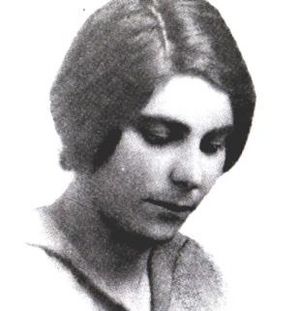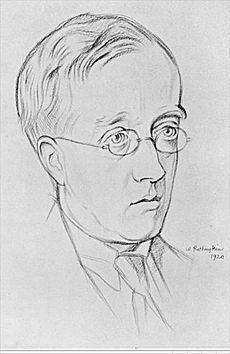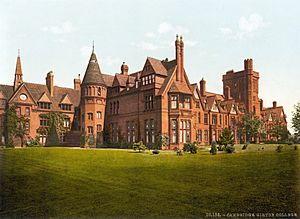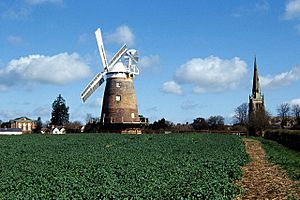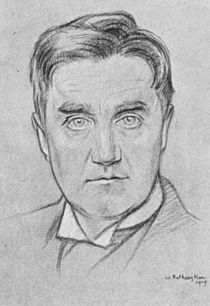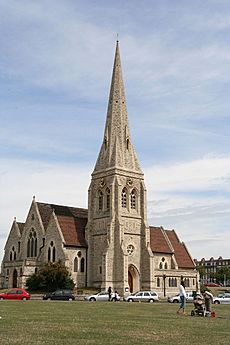Jane Joseph facts for kids
Jane Marian Joseph (born May 31, 1894 – died March 9, 1929) was an English composer, arranger, and music teacher. She was a student and later worked closely with the famous composer Gustav Holst. Jane was very important in organizing many music festivals that Holst supported. She wrote many of her musical pieces for these festivals and similar events. She died young at age 35. Her friends and colleagues felt this was a big loss for English music because she had so much talent.
Holst first saw Jane's potential when he taught her music composition at St Paul's Girls' School. She started helping him in 1914. At this time, he was writing his famous work, The Planets. Her special job was to prepare the music score for the "Neptune" part. She kept helping Holst with copying music, arranging pieces, and translating texts. She also wrote the story for his choral ballet The Golden Goose.
During her short career, Jane became an active member of the Society of Women Musicians. She was the main person behind the first Kensington Musical Competition Festival. She also helped start the Kensington Choral Society. Jane taught music at a girls' school, where Holst's daughter Imogen was one of her students. She also became a leading figure in the musical life of Morley College. After she died, two special prizes and scholarships were created in her name.
Most of Jane Joseph's music was never published and is now lost. Of her published works, two early short orchestral pieces, Morris Dance and Bergamask, received a lot of praise. However, they are not often played by orchestras today. Two of her choral works, A Festival Venite and A Hymn for Whitsuntide, were admired during her lifetime. But they were never recorded for sale. Since her death, her work has rarely been performed, but it has sometimes been played on the radio. Holst thought her carol "A Little Childe There is Ibore" was one of the best carols of its kind.
Jane Joseph's Life Story
Her Family and Early Years
Jane Joseph was born on May 31, 1894, in London. Her family was wealthy and lived in the Notting Hill area. Her father, George Solomon Joseph (1844–1917), was a lawyer. He married Henrietta Franklin (1861–1938) in 1880. Jane was their fourth child and the youngest. Her three older brothers were all at least seven years older than her.
George Joseph loved music very much, and he shared this love with his children. Two of her brothers, Frank and Edwin, became good at playing string instruments. Jane learned to play the piano and later the double-bass. She took her first piano exam when she was just seven years old. Over time, Frank's children, Jane, and friends formed a "Josephs orchestra." They performed concerts at Frank's home for many years.
Studying at St Paul's Girls' School
In 1909, Jane Joseph won a scholarship to St Paul's Girls' School (SPGS) in Hammersmith. This school had opened in 1904. The headmistress, Frances Ralph Gray, was a strong leader. She had traditional ideas about girls' education. However, she created a lively and interesting learning place where Jane did very well.
Besides her school successes, Jane played double-bass in the school orchestra. She also gave a praised piano performance of Bach's D minor keyboard concerto. She started to compose music and won a prize for reading music at first sight. While at the school, she wrote "The Carrion Crow." This song was published in 1914 and was her first published work. Outside of music, she was part of the school's Literary Society. She gave talks about famous writers like Charlotte Brontë and Samuel Taylor Coleridge. She also earned honors in drawing exams.
At SPGS, Jane met the composer Gustav Holst, who was not yet famous. He taught her composition. Holst later said she was the best girl student he ever had. He said she "showed an individual attitude of mind and an eagerness to absorb all that was beautiful." Jane quickly admired Holst and followed his ideas.
Student, Helper, and Teacher (1913–1918)
College Life at Girton
In the autumn of 1913, at age 19, Jane started studying Classics at Girton College, Cambridge. At that time, women could not officially get degrees from Cambridge University. But they could take the same exams as men. Jane soon found many activities at the university that took her attention from her studies. She enjoyed debating, drama, and especially music.
In her first term, she played double-bass in the Cambridge University Musical Society orchestra. She also sang alto in the choir. During her school breaks, she continued her composition studies with Holst. In 1916, her "Wassail Song" was published. This song was a companion piece to "The Carrion Crow." At Girton, she wrote music for a play by W. B. Yeats called The Countess Cathleen. She also acted in the play.
From 1915, Jane's connection with Holst grew stronger. Holst was very busy with teaching and other duties. He needed help organizing his music for publishing and performances. He used a group of young women volunteers, called his "scribes," to copy his music scores. They also wrote out parts for instruments or singers, or made piano versions. In 1915, Holst was working on his biggest and most famous work, The Planets. He invited Jane to join his scribes during her vacations. Jane's main job for The Planets was to copy the "Neptune" movement. Most of the original manuscript for this part is in her handwriting. For the rest of her career, she was one of Holst's most regular helpers. He came to rely on her more than anyone else.
Her many music activities at Girton and her work for Holst affected her formal studies. In her 1916 exams, she only got a Class III pass. This was a disappointing result for her college.
Starting Her Career
When Jane left Girton, World War I was at a very important stage. Jane wanted to help with the war effort. She thought about working on farms or in weapons factories. Instead, she took a part-time job helping people in Islington. In the autumn of 1916, she started teaching at Eothen, a small private school for girls. In 1917, Holst's ten-year-old daughter Imogen started at the school. Soon, with Jane's help, young Imogen was composing her own music.
Jane also joined the orchestra at Morley College, where Holst was the music director. At first, she played the double-bass. Later, she took French horn lessons. Even later, she quickly taught herself to play the timpani (kettledrums) for a summer concert. By 1918, she was part of the Morley committee. This group organized an opera show called English Opera as She is Wrote. It made fun of different opera styles. The show was very successful and was performed many times. It might have inspired Holst to use humor in his own opera, The Perfect Fool. In her free time, Jane started and ran a choir for nannies in Kensington. This choir, called the "Linden Singers," took part in local singing contests.
Jane took on more teaching duties. She often filled in for Holst at James Allen's school and at SPGS. She also continued to help Holst copy his music. She was invited to the first private performance of The Planets on September 29, 1918. It was held at the Queen's Hall. She later wrote: "From the moment of Mars ... to the last sound of Neptune, it was a big thing that will last all our lives, I think."
She used her Classics education from Girton to help translate an ancient text called The Acts of John from Greek. This text was used for Holst's The Hymn of Jesus (1917). For the same work, she prepared a vocal score and an arrangement for piano, strings, and organ. She and Holst also worked together to create a version for women's voices of William Byrd's Mass for Three Voices. Jane worked alone to create an orchestral accompaniment for Samuel Wesley's Sing Aloud with Gladness. This last piece was prepared for the 1917 Whitsun music festival. This was one of a series of yearly festivals that Holst organized. Jane became a key person in these festivals. She was an organizer, performer, and composer. At the Thaxted festival in 1918, two of her pieces were performed: Hymn for female voices (now lost) and an orchestral piece, Barbara Noel's Morris.
The years 1917 and 1918 also brought sadness. On October 22, 1917, Jane's father died. The next year, on May 27, her brother William was killed in the war. In September, her brother Edwin was badly wounded.
Teacher, Organizer, and Composer (1918–1928)
After the War
In 1919, Jane joined the Society of Women Musicians (SWM). This group was started in 1911 to support women in music. Jane became a member of the SWM's Composers' Committee. She sometimes gave talks to the society. In the summer of 1919, she took conducting lessons. This was so she could conduct her orchestral work Bergamask. It was performed at the Coliseum Theatre to show new British music. That same summer, she met Ralph Vaughan Williams, a close friend of Holst. She played some of her music for him, and she said he was "a very appreciative critic."
Holst had asked Jane to write the story for his opera The Perfect Fool. It is not clear if she said no, or if Holst changed his mind. He ended up writing the story himself. However, Jane did write the story for a ballet based on Holst's music. The ballet, called A Magic Hour, was performed in October 1920. Meanwhile, Jane's works were performed at SWM concerts.
At Eothen school, Jane continued to guide Imogen Holst's music education. Holst had been worried about some parts of Imogen's learning. But Jane helped solve these issues. Jane became Imogen's music theory teacher. Imogen said, "Theory with Jane is ripping!" In the summer of 1920, with Jane's help, Imogen created a "Dance of Nymphs and Shepherds." It was performed at the school. In early 1921, Imogen started at SPGS. Before becoming a boarder, she stayed at the Joseph family home.
The Whitsun festivals, which stopped when Holst was away, started again in 1920. Jane made a big contribution to the 1921 festival. For this event, Jane created a performance of Purcell's 1690 opera, Dioclesian. Holst later remembered that Jane had used Purcell's music and an old text to create a "delightful out-door pageant." It was based on a fairy tale with a lost princess and a dragon. Jane planned every part of the outdoor show. She even prepared an indoor version in case of bad weather. The show was a great success. It was repeated in Hyde Park and later at the Old Vic theatre. Holst wrote that Jane made things easy for everyone else by doing "the maximum of hard work and forethought" herself.
Peak of Her Career
In November 1921, Jane organized a large show at Morley College. It celebrated 200 years of the church of St Martin-in-the-Fields. The music was directed by Holst. In the following year, Jane's growing fame as a composer was clear. Her Seven Two-Part Songs were performed at an SWM concert. Two of Jane's works, A Hymn for Whitsuntide and A Festival Venite, were first played at the 1922 Whitsun festival. Holst conducted them. After the Venite was first played, Jane wrote to Holst, "Do you suppose for one moment that any other conductor takes trouble like that? If you do, you are quite wrong." The Venite was performed again in June 1923 at the Queen's Hall. A critic called it a "very notable addition to modern British music."
Among her composing and other activities, Jane found time in 1922 to organize the first Kensington Musical Competition Festival. She also arranged many of the competition songs for orchestra. This festival became an important yearly event in Kensington. Ralph Vaughan Williams was one of the judges. On October 12, 1922, Vaughan Williams's 50th birthday, Jane organized a choir. They gave an early-morning surprise performance in his garden. They sang a song she had written for the occasion.
As early as 1919, Jane had worried about Holst's health. In 1923, Holst had a physical breakdown and stopped working at Morley College. Jane wrote him a supportive letter. She congratulated him on his decision to focus on composing. The next few years were very productive for Holst. Jane helped him with many works he created between 1924 and 1928. She helped him prepare the score for his Choral Symphony. As thanks, he gave her his original draft sketches.
Together with other helpers, she prepared music scores for the opera At the Boar's Head. She attended the rehearsals in March 1925. After the opera's first performance, she wrote to Holst with comments on the singers. She praised the young conductor, Malcolm Sargent. When Holst wrote a short choral piece for the Oriana Madrigal Society's 21st birthday, Jane wrote words for it. They humorously described the conductor's working style. The choir loved the work. In that same year, 1925, she helped start the Kensington Choral Society. By this time, the Joseph family home in Kensington, where Jane lived her whole life, became a well-known place for musicians to gather.
In 1926, Jane gave Holst the story for his choral ballet The Golden Goose. It was based on a story by the Brothers Grimm. She also organized its first performance at the 1926 Whitsun festival. Jane also helped Holst with a second choral ballet, The Morning of the Year. This was the first work asked for by the BBC's new music department. It was performed in March 1927. The Morley College Annual Report of 1927 noted that a folk dance club was formed. It praised Jane's "skilful direction" of the group. Her growing interest in dance led her to join the English Folk Dance Society and the Kensington Dance Club that year.
Illness, Death, and Tributes
The main event of the 1928 Whitsun festival, held in Canterbury, was a religious play called The Coming of Christ. Holst wrote the music for it. In a photograph of the festival's organizers, Jane is sitting between Holst and Mrs. Bell. She looks like an important person for the festival. This was Jane's last Whitsun festival.
Towards the end of 1928, her health began to fail. In February 1929, she paid the last amount owed for Morley's new piano. She had been raising money for it since 1926. On March 9, 1929, Jane Joseph died at home in Kensington. She died from kidney failure. After a private funeral, she was buried in Willesden Jewish Cemetery.
Holst was in Venice when he heard the news of Jane's death. His daughter Imogen said he took it calmly, but he was very sad in private. Imogen wrote that Jane "came nearest to his ideal of clear thinking and clear feeling." In his own tribute, Holst pointed out Jane's "infinite capacity for taking pains which amounts to genius."
No Whitsun festival was held in 1929. But in early July, at a performance of Holst's The Golden Goose, a special performance of his St Paul's Suite was played in Jane's memory. On December 5, 1929, Ralph Vaughan Williams conducted a choir in Jane's Hymn for Whitsuntide. The audience stood up as a tribute. The same hymn was played at the first Whitsun festival after the break, in May 1930. In July 1931, Holst included her music in a concert he conducted. Over the next few years, Jane's works were played at concerts organized by Morley College, the SWM, SPGS, and the English Folk Dance Society. At Eothen school, a "Jane Joseph Memorial Prize" was created. Music scholarships were also set up in her name at Eothen and SPGS.
A friend who was sad about Jane's death said something else about her. "England won't be the same without Jane. She was terribly difficult to get to know at all, and awfully lonely, I thought, in spite of all her friends—don't you think so?—but I can't imagine Music without her."
Jane Joseph's Music
Most of Jane Joseph's music was written for small performances by amateur musicians. Because of this, it was never published, and many works have been lost over the years. The published works and the few others that still exist show that Jane was a "progressive" English composer.
Her first few pieces were mostly songs. But she quickly showed talent as an orchestral composer. Her two short pieces, Morris Dance (1917) and Bergamask (1919), show a "fine feeling for orchestral sound." The Morris Dance has a bright sound from a glockenspiel. Bergamask has a lively, Italian feel. Other music writers have praised Jane's confident way of handling the large orchestra needed for the Morris Dance. Another composer, Havergal Brian, found Bergamask "exhilarating" and "full of promise." It's a shame that these fun pieces are not played more often today.
Miss Joseph's 'Venite' is written in a great tradition... however much the 'Venite' owes in spirit to the Tudor composers, it is an individual and self-supporting growth from that great tree, and its roots draw energy and life from fresh, unvitiated ground."
In Jane Joseph's Mirage song cycle from 1921, you can hear Holst's influence. But she also has her own unique style. The first song, "Song," sounds a bit like Holst's "To Varuna" at first. But it becomes its own piece, with clear string quartet writing. The last song, "Echo," sounds like Brahms as much as Holst.
Jane's Festival Venite from 1922 uses the Modern Dorian mode. This became a feature in some of her later works. This piece also shows influences from older Tudor composers. It also has the friendly influence of Ralph Vaughan Williams in its melody and harmony. The orchestral music for this work is lost, but an organ accompaniment has been created. Jane's Hymn for Whitsuntide, sung without instruments, also uses the Dorian Mode. Holst called it a "flawless little motet." This was the first of Jane's works to be played on the radio, in 1968. A Short String Quartet was performed in December 1922 and was accepted for publishing. However, it was never published and later disappeared.
Jane's carol "A Little Childe There is Ibore" uses a 15th-century poem for three female voices and piano or strings. Holst thought this was "the best of Jane's many carols, and perhaps the hardest to perform well." It was praised for being original. It was finally played on the BBC radio on December 21, 1995.
Havergal Brian also liked Jane's many piano pieces for teaching. He called them "pleasingly simple and unaffected." These were published between 1920 and 1925. These pieces focus on teaching technical skills in a musical way. They sometimes explore other forms like chaconne and rondo.
Images for kids
See also
 In Spanish: Jane Joseph para niños
In Spanish: Jane Joseph para niños


